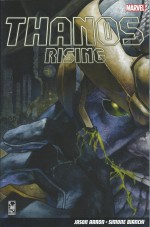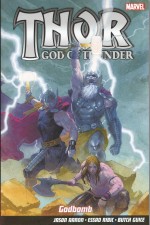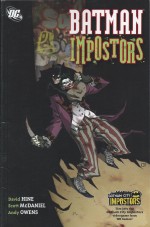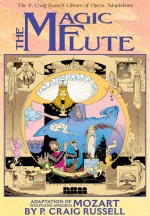
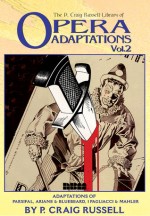
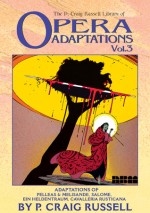
By P. Craig Russell & various (NBM)
Set ISBN: 978-1-56163-755-3
Vol. 1 ISBN: 978-1-56163-350-0
Vol. 2 ISBN: 978-1-56163-372-2
Vol. 3 ISBN: 978-1-56163-388-3
Win’s Christmas Gift Recommendation: Startling, seductive and sublime… 10/10
Here’s a tremendous opportunity and irresistible bargain for aficionados of magnificent Art and Grand Spectacle…
P. Craig Russell began his illustrious career in comics during the early 1970s and came to fame early with a groundbreaking run on science fiction adventure series Killraven, Warrior of the Worlds. His fanciful, meticulous classicist style was derived from the great illustrators of Victorian and Edwardian heroic fantasy and was greatly at odds with the sausage-factory deadlines and sensibilities of the mainstream comicbook industry.
By the 1980s he had largely retired from the merciless daily grind, preferring to work on his own projects (generally adapting operas and plays into sequential narratives) whilst undertaking the occasional high-profile Special for the majors – such as Dr. Strange Annual 1976 (totally reworked and re-released as Dr. Strange: What Is It that Disturbs You, Stephen? In 1996) or Batman: Robin 3000.
As the industry grew up and a fantasy boom began he returned to comics with Marvel Graphic Novel: Elric (1982), further adapting Michael Moorcock’s iconic sword-&- sorcery star in the magazine Epic Illustrated and elsewhere.
Russell’s stage-arts adaptations had begun appearing in 1978: first in the independent Star*Reach specials Night Music and Parsifal and then from 1984 at Eclipse Comics where the revived Night Music became an anthological series showcasing his earlier experimental adaptations; not just operatic dramas but also tales from Kipling’s Jungle Books and others.
In 2003 Canadian publisher NBM began a prodigious program to collect all those music-based masterpieces into The P. Craig Russell Library of Opera Adaptations: first as the luxurious clothbound hardcovers under discussion here and eventually in more affordable trade paperback albums.
Now all three of the sturdy originals are available again as a lavish economical shrink-wrapped set no fan of the comic arts could possibly resist.
Completed in 1990, the first huge volume (300 x210mm) features an epic rendering of Mozart’s lush fairytale romance The Magic Flute (from Emanuel Schikaneder’s libretto) wherein valiant if lackadaisical Prince Tamino and his unwelcome but supremely practical bird-catcher sidekick Papageno are tricked by the Queen of Night into rescuing her daughter Pamina from the wicked sorcerer Sarastro.
To aid them she gave the Prince a Magic Flute and the oafish dullard a set of enchanted bells, but she had not told them the true nature of the victim or their opponents…
A glorious panorama of love, betrayal, duplicity, enchantment and comedy – and dragons! – this is a fabulous example of the artist’s visual virtuosity.
Volume 2 is comprised of shorter works, beginning with the aforementioned Parsifal, realised from the Second Act of Richard Wagner’s opera, with a script adapted by long-term collaborator Patrick C. Mason, who also provides an Introduction and erudite commentary.
The work is the earliest represented in the collection and still contains stirring remnants of Russell’s action-hero style as the pure and heroic knight (a “germanised†version of Camelot’s Sir Percival in quest of the Holy Grail) finds the doughty and beautiful seeker undertaking ‘His Journey’, facing the seductive wiles of the debased siren Kundry and her Flower-Maidens in ‘His Temptation’ before eventually achieving ‘His Victory’ over malign magic and the weaknesses of the flesh…
Letitia Glozer’s Introduction to Songs by Mahler precedes two powerful evocations of ferocious imagination as ‘The Drinking Song of Earth’s Sorrow’ (with a script by Mason) and the idyllic Arcadian pastel dreamscape of ‘Unto This World’ bemuse the reader until the opening of dark fairytale horror with ‘Ariane & Bluebeard’.
As revealed in Olivier Messiaen’s Introduction, Maurice Maeterlinck’s poem became a stunning symbolist opera scored by Paul Dukas, and Russell’s adaptation maintains the philosophical underpinnings whilst deftly telling of a township in revolt as the brutal lord of the manor brings his sixth bride to his castle.
The peasants are determined that the killer will not destroy another maiden but strong-willed Ariane has her own opinions and will determine her own fate…
Russell himself provided the Introduction for the final work in this volume. ‘The Clowns’ is crafted in stark and memorable monochrome, eschewing the vibrant colours of the previous pieces for a horrific interpretation of Ruggero Leoncavallo’s I Pagliacci – a play-within-a-play of the new “Verismo†school of operatic storytelling which abandoned fantasy for tales of ordinary people and tawdry, sordid realism.
Pencilled by Galen Showman over Russell’s layouts and under the master’s inks and tones, it concerns a band of travelling players, who find that close proximity breeds boredom not fidelity, and proves that sinful passions indulged cannot help but lead to jealousy and murder…
The wide-eyed full colour wonderment wraps up in the third P. Craig Russell Library of Opera Adaptations, which features Pelleas and Melisande, Salome, Ein Heldentraum and Cavalleria Rusticana.
Mason’s informative Introduction to Maeterlinck’s masterpiece of forbidden love and familial injustice (as set to music by Claude Debussy) precedes a superb adaptation by Russell and scripter Barry Daniels, which relates how gruff widower Prince Golaud finds a strange, forlorn young woman whilst out hunting and, smitten with the sad, beautiful creature, marries her. He was supposed to wed distant Princess Ursula whose alliance might have saved the impoverished and slowly starving kingdom…
Melisande doesn’t really care. She seems to carries a mysterious secret within that manifests as a quiet compliance. She only really appears to display any passion for life after her new husband’s brother Prince Pelleas returns to court. As the two young people spend time together, Golaud is wracked with growing suspicion and when his bride loses her wedding ring the scene is irretrievably set for tragedy…
Scripted by Mason again, ‘Ein Heldentraum’ (A Hero’s Dream) is a short piece completed for this volume, visualising a bleak Lied or Art Song by German composer Hugo Wolf – a minor epic of fantastic imagination with just the hint of a potential happy ending.
That can’t be said of the next tale. ‘The Godfather’s Code’ is also new: a cruel, grim tale of death and broken promises taken from the Cavalleria Rusticana (rustic or peasant’s chivalry) by Pietro Mascagni from the libretto by Giovanni Targioni-Tozzetti and Guido Menasci as originally adapted from a play and short story written by Giovanni Verga.
It was the first great example of the Verismo opera and is also one of Russell’s most effective adaptations.
Depicted in the bright, vivid colours of an Italian Easter, the story concerns vivacious Lola who revels in the first flowering of a new romance, even as fallen woman Santuzza desperately seeks the man for whose attentions she gave her virtue and now stands excommunicated by the Church and damned by her own conscience…
The outcast kneels in prayer outside the chapel, hungry for a glance of her adored Turridu, but she knows in her heart he has abandoned her for his first love.
When at last he arrives, the cad discards her whilst hypocritical Lola mocks. Thus Santuzza is driven to do the unpardonable: tell proud carter Alfio what his wife and best friend do whilst he works away from home…
The grandeur and tragedy all concludes with the biblical horror story of ‘Salome’ transformed from Oscar Wilde’s play into Richard Strauss’ opera of “shocking depravity†and thus perfect meat for comics cognoscenti.
In ancient Judea, the Tetrarch Herod rules by the grace of Rome, in a Court of utter decadence and indulgence. His wife is the debauched wanton Herodias, but lately even she has paled in the King’s eyes as her daughter Salome has blossomed.
The queen’s every blandishment is useless as her husband becomes more and more obsessed with the virginal sixteen year old…
Have grown up in the most debased place on world Salome is under no illusions as to Herod’s attentions or intentions, but her mind is preoccupied by the strident prisoner pent in the hole beneath the palace floor. Jokanaan condemns everything about the Court and warns all who hear of the messiah to come, heedless of the danger to himself. He is also exceedingly beautiful, as wilful Salome discovers when she forces a besotted guard to let him out so that she can see him. The precocious child has never met anyone who did not want her and John the Baptist’s indifference enflames her. The prophet is someone worthy of her body and chastity so she throws herself at him, but is roundly rejected.
Her passions aroused and rebuffed, the furious, confused girl decides to do anything she must and give everything she is if it will punish her tormentor…
The astounding strips and stories contained here are an indisputable high point in the long, slow transition of an American mass market medium into a genuine art form, but they are also incredibly lovely and irresistibly readable examples of comics on their own terms too.
This collection is a grand spectacle all lovers of picture storytelling would be crazy to miss.
© 1977, 1978, 1984, 1986, 1989, 1990 1998, 2004, 2013 P. Craig Russell. All rights reserved.






